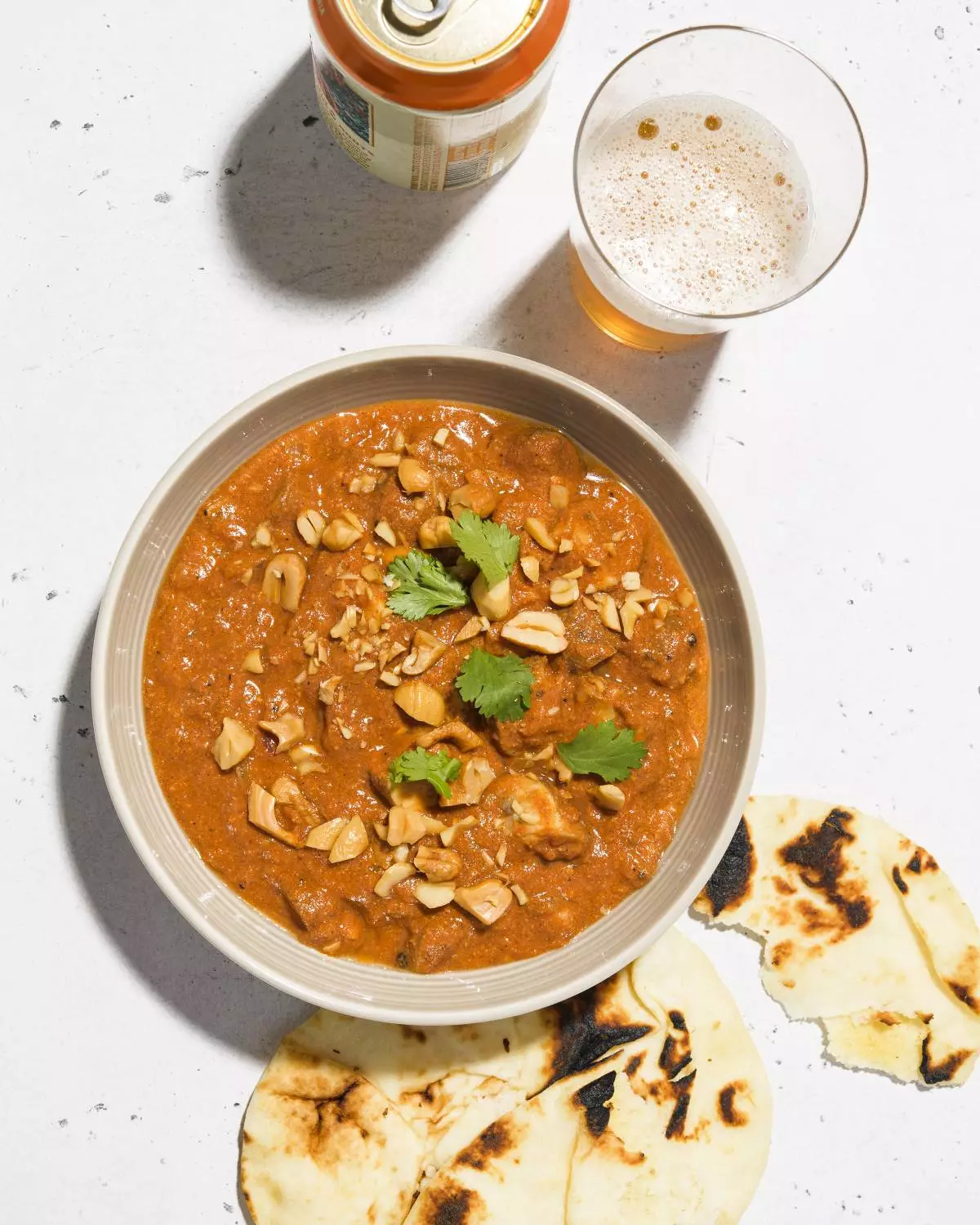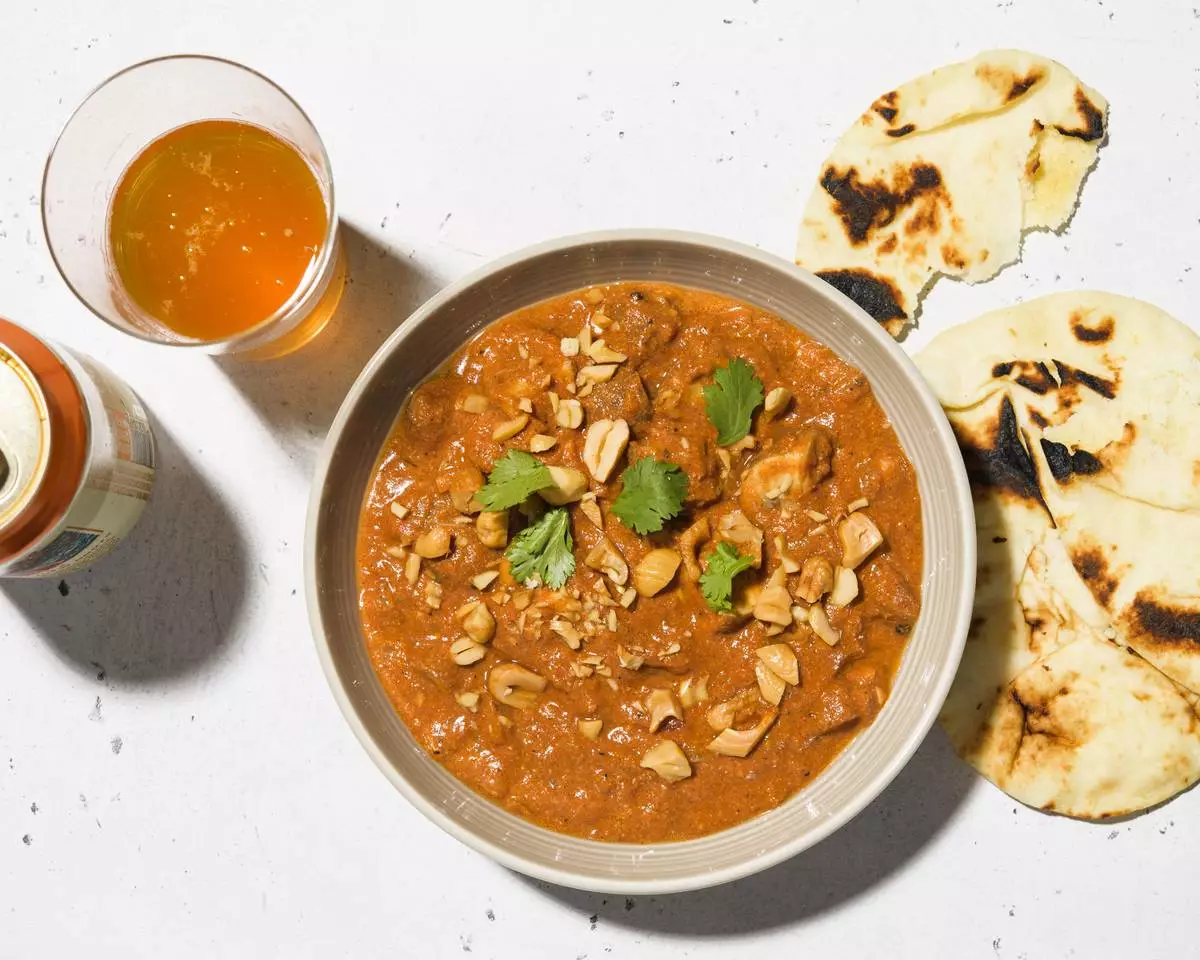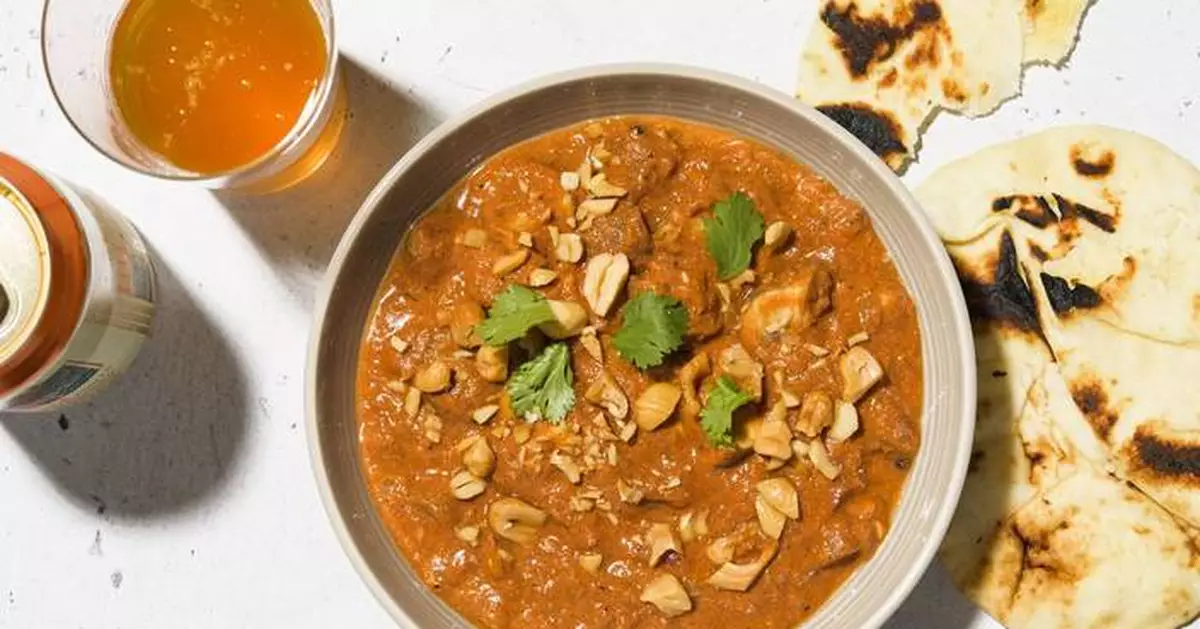Many recipes for Indian curries such as tikka masala and butter chicken call for copious amounts of butter, yogurt and cream to give them a rich, satisfying texture. For a lighter vegetarian interpretation of the takeout classic, meaty cremini mushrooms stand in for chicken and pureed cashews make up the base of the curry.
In this recipe from our book “Cook What You Have,” which draws on pantry staples to assemble easy, weeknight meals, we soften cashews in a bit of water, then blend them until smooth to make a puree that lends creamy texture without making the dish heavy.
The puree then is cooked with an aromatic mixture of onion, garlic, ginger, garam masala and paprika until it begins to brown, concentrating the flavors. Canned tomatoes and water are added to release any browned bits and ensure no flavor is left behind on the pan. Cremini mushrooms are simmered until tender and the sauce is creamy. If you have only white mushrooms on hand, they’ll work well, too.
For a pop of color, stir ½ cup thawed frozen peas into the curry at the end of cooking. Warm naan or nutty brown rice are wonderful accompaniments.
Tomato-Mushroom Curry
Start to finish: 40 minutes
Servings: 4
½ cup roasted salted cashews, plus 2 tablespoons chopped cashews, divided
3 tablespoons grapeseed or other neutral oil
1 medium yellow onion, finely chopped
4 medium garlic cloves, minced
1 tablespoon finely grated fresh ginger
1 tablespoon garam masala
2 teaspoons hot paprika OR 2 teaspoons sweet paprika plus ⅛ teaspoon cayenne pepper
Kosher salt and ground black pepper
14½-ounce can crushed tomatoes
1 pound cremini OR white mushrooms, trimmed, halved if medium, quartered if large
In a blender, combine the ½ cup cashews and ⅓ cup water; soak for about 10 minutes. Puree on high until smooth, scraping the jar as needed, 1 to 2 minutes; set aside.
In a 12-inch skillet over medium, heat the oil until shimmering. Add the onion and cook, stirring occasionally, until beginning to brown, 6 to 9 minutes. Add the garlic, ginger, garam masala, paprika and ½ teaspoon pepper; cook, stirring, until fragrant, about 1 minute. Add the cashew puree and cook, stirring often, until browned and sticking to the bottom of the skillet, about 2 minutes.
Add the tomatoes and ¾ cup water, scraping up the browned bits, then stir in the mushrooms and ¾ teaspoon salt. Cover, reduce to medium-low and cook, stirring occasionally and scraping along the bottom of the pan to prevent sticking, until the mushrooms are very tender and the sauce is creamy, 10 to 15 minutes. Off heat, taste and season with salt and pepper. Serve sprinkled with the chopped cashews.
Optional garnish: Chopped fresh cilantro OR lemon wedges OR both
EDITOR’S NOTE: For more recipes, go to Christopher Kimball’s Milk Street at 177milkstreet.com/ap

This image released by Milk Street shows a recipe for tomato mushroom curry. (Milk Street via AP)

This image released by Milk Street shows a recipe for tomato mushroom curry. (Milk Street via AP)
WELLINGTON, New Zealand (AP) — As professional rugby teams and tournaments around the world contend with tough financial headwinds, Japan continues to buck the trend with historic growth in teams and crowds.
The Japan Rugby League One will add three new clubs next season, growing to 26 teams over three divisions.
The Secom Rugguts, based in Saitama, Yakult Levins, based in Toda, and LeRIRO Fukuoka, based in Ukiha City, will join the third division. The first division will have 12 teams, the second division will have eight and there'll be six in the third division.
Large corporations in Japan continue to show a strong interest in getting involved in rugby through team sponsorship. Top foreign players are being drawn to Japan at a younger age than in the past, and they're staying for longer.
At the same time, the picture for professional rugby is challenging in many other countries.
In England, two powerful clubs — Wasps and Worcester Warriors — have collapsed financially and closed down. London Irish has debts of more than 30 million pounds (US$38 million) and might have failed but for a takeover bid.
Losses by Premiership Rugby in Britain have doubled in the past year to 36 million pounds ($46 million). Many individual clubs there are heavily in debt.
New Zealand Rugby had a financial deficit of 47 million New Zealand dollars ($29 million) in 2023 and is expected to make a loss again this season. Officials recently have discussed reducing the number of professional teams the national body supports.
Rugby Australia made a $9.2 million Australian dollar ($6.4 million) loss last year and has debts of almost A$90 million ($60 million). The Melbourne Rebels Super Rugby team is on the brink of being dissolved.
The French Top 14 competition and teams so far remain profitable, mainly with the support of wealthy backers.
Japan Rugby League One, currently in its third year, continues to strengthen in the wake of the country hosting the 2019 Rugby World Cup.
The response to the league has been positive from fans, from broadcasters, from sponsors and corporate team owners and from foreign players.
“What I’m hearing from the foreign players is that they are enjoying the playing environment here and also liking the environment for their families,” JRLO chief operating officer Hajime Shoji said.
“The supporting companies also are very happy to observe the increasing enthusiasm for the high level of the games. Therefore, we are meeting the expectations of Japanese corporations, existing ones and new ones.”
Long-serving All Blacks forward Sam Cane is among the elite foreign players who have sampled the league in Japan while taking a break from their national or domestic rugby commitments. Cane announced earlier this week that he'd asked for a release from the last year of his New Zealand Rugby contract — 2025 — to take up a three-year deal with Tokyo-based Suntory Sungoliath.
The high-profile players are attracting bigger crowds. More than one million fans have attended League One matches so far this season, up from 750,000 last year, with the semifinals and final still to be played.
Crowds of around 18,000 are expected to attend semifinals on Saturday and Sunday — attendance is limited by stadium capacity — and more than 50,000 likely will attend the following week’s final at the 68,000-seat National Stadium.
“The target for this year was 900,000 and to have 1.1 million by the end of the season will have well exceeded that target. Our aspiration or high expectation is for a continued increase,” JRLO chairman Genichi Tamatsuka said.
“I appreciate those really great players who are coming to Japan who are setting higher standards in the level of rugby and are setting a very positive influence for the Japanese players."
The next phase for the league may involve further expansion.
“We divide our (development) into three phases,” Tamatsuka said, outlining a nine-year plan in three, three-year stages. “We are now finishing the first phase. I and Hajime and the other team members, general managers of teams and everyone, we should sit together review these first three years and review what was good, what should be improved and what were the problems for the teams’ perspectives.”
The way in which the league contributes to the performance of the Japan national team is one consideration.
“We sit down and discuss whether the current format is the right one or how many games we should have in the season or what sort of cross-border games we should seek,” Tamatsuka said. “Rugby’s growth is strong in the Asia-Pacific region and we want to make League One the center of the Asia-Pacific.
“We are going in a good direction and next year is going to be exciting again.”
AP rugby: https://apnews.com/hub/rugby

All Blacks captain Sam Cane runs during the second Bledisloe Rugby test between the All Blacks and the Wallabies at Eden Park in Auckland, New Zealand, Sunday, Oct. 18, 2020. Cane announced Monday May 13, 2024 that he was retiring from international rugby at the end of the 2024 season. (AP Photo/Mark Baker)












